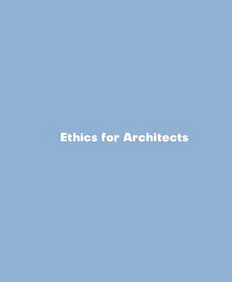
Ethics for Architects: 50 Dilemmas of Professional Practice (Architecture Briefs) PDF
Preview Ethics for Architects: 50 Dilemmas of Professional Practice (Architecture Briefs)
Ethics for Architects Ethics for Architects 50 Dilemmas of Professional Practice Thomas Fisher Princeton Architectural Press, New York The Architecture Briefs series takes on a variety of single topics of interest to architecture students and young professionals. Field- specific information and digital techniques are presented in a user-friendly manner along with basic principles of design and construction. The series familiarizes readers with the concepts and technical terms necessary to successfully translate ideas into built form. Also available in this series: Architects Draw: Freehand Fundamentals Sue Ferguson Gussow 978-1-56898-740-8 Digital Fabrications: Architectural and Material Techniques Lisa Iwamoto 978-1-56898-790-3 Building Envelopes: An Integrated Approach Jenny Lovell 978-1-56898-818-4 Architectural Photography the Digital Way Gerry Kopelow 978-1-56898-697-5 To my father, who first sparked my interest in ethics, and my mother, who showed me how to live a good life Published by Princeton Architectural Press 37 East Seventh Street New York, New York 10003 For a free catalog of books, call 1.800.722.6657. Visit our website at www.papress.com. © 2010 Princeton Architectural Press All rights reserved Printed and bound in China 13 12 11 10 4 3 2 1 First edition No part of this book may be used or reproduced in any manner without written permission from the publisher, except in the context of reviews. Every reasonable attempt has been made to identify owners of copyright. Errors or omissions will be corrected in subsequent editions. Editor: Dan Simon Designer: Jan Haux Special thanks to: Nettie Aljian, Bree Anne Apperley, Sara Bader, Nicola Bednarek Brower, Janet Behning, Becca Casbon, Carina Cha, Tom Cho, Penny (Yuen Pik) Chu, Carolyn Deuschle, Russell Fernandez, Pete Fitzpatrick, Linda Lee, Laurie Manfra, John Myers, Katharine Myers, Steve Royal, Andrew Stepanian, Jennifer Thompson, Paul Wagner, Joseph Weston, and Deb Wood of Princeton Architectural Press —Kevin C. Lippert, publisher Library of Congress Cataloging-in-Publication Data Fisher, Thomas, 1953– Ethics for architects : 50 dilemmas of professional practice / Thomas Fisher. p. cm. — (Architecture briefs series) ISBN 978-1-56898-946-4 (alk. paper) 1. Architects—Professional ethics. 2. Architecture— Moral and ethical aspects. I. Title. NA1995.F57 2009 174’.972—dc22 2009036440 Contents Introduction 10 1 2 General Obligations Obligations to the Public Conflicts of Interest Repressive Governments 17 39 Uncompensated Work Corrupt Politicians 19 41 Community Service Public Officials 21 44 Pro Bono Work Public Opinion 23 46 Living Conditions Public Bailouts 25 49 Working Conditions Public Reviews 28 52 Layoffs Public Health 30 54 Unequal Pay Cultural Differences 33 57 3 4 Obligations Obligations to the Client to the Profession Self-Destructive Behavior Greed 63 87 Distrustful Behavior Insensitivity 65 89 Dishonest Behavior Jealousy 68 91 Deceptive Behavior Betrayal 70 94 Spendthrift Behavior Treachery 72 96 Solicitous Behavior Unfairness 75 99 Unrealistic Expectations Uncertainty 77 101 Manipulative Situations Cheating 79 104 Deceiving a Client 82 5 6 Obligations Obligations to Colleagues to the Environment Office Affairs Environmental Hypocrisy 109 131 Working Hours Environmental Conflicts 111 133 Labor Law Violations Contextual Conflicts 113 136 Crediting Coworkers Social Justice 116 138 Accommodating Disabilities Future Generations 118 140 Firm Bankruptcy Other Species 120 143 Firm Loyalties Reducing Waste 123 145 Untrustworthy Colleagues Reducing Consumption 125 147 Rights of Nature 150 Postscript: Why Ethics Matters Now 152 Introduction I began my architectural career with an ethical dilemma, when a firm agreed to let me work for them—for free. Still in school, I needed money, but I also needed the experience, and so I accepted their offer, aware of the unfairness of it, not only to me but also to others who could not agree to such terms because they depended on summer jobs to pay for their education. That experience introduced me to the way architectural offices worked, and it also initiated my interest in the ethics of professional practice, which led to this book. Like most people, architects want to do the right thing. That is often easier said than done, however, as I show in the case studies that follow, which are based on situations that I have encountered directly or have heard of from colleagues. In each case I try to sort out the most appropriate response, drawing from the four major approaches to Western ethics: what it means to be a good person (virtue eth- ics) or to have a good society (contract ethics), and what is the right action in terms of the individual (duty ethics) or the group (utilitarian ethics). A tabulation of the four approaches might look like this: Good Character Right Action Individual Virtue ethics Duty ethics Group Contract ethics Utilitarian ethics These four approaches to ethics relate to four of the phases of architectural projects: pursuing and attaining the commission, assembling the team and signing the contract, developing the design and contract documents, and administering the construction and close-out of the project. Although all phases of an architectural project can raise a diversity of ethical dilemmas, each phase tends to draw more heavily on one approach to ethics more than others. The gaining of a commission often depends as much on the character of the architect and the chemistry between the client and designer as on anything that the firm has already built. Here, virtue eth- ics, with its emphasis on character traits such as honesty, integrity, and fairness, can make the difference between an architect and client developing a good working relationship or not. Upon receipt of a commission, though, the architect’s command of contract ethics becomes more important. The negotiation of the rights and responsibilities of different parties, the heart of social contract theory, plays itself out in the agreements between architects and clients, as well as in those between architects and consultants. Doing this well, without antagonizing others or disadvantaging ourselves, makes all the differ- ence between good and bad relations in a project.
